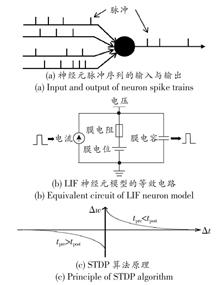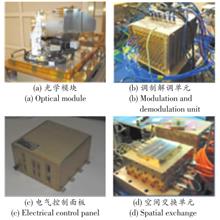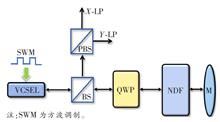Search by keywords or author
Journals >Study On Optical Communications
Export citation format
Research Articles
Silicon Photonic 2.5D/3D Integration Technology and Its Applications
Xiang-peng OU, Zai-li YANG, Bo TANG, Zhi-hua LI... and Yan YANG|Show fewer author(s)
With the explosive growth of global network traffic and the consequent increase in bandwidth and energy consumption required for data transmission, traditional electronic interconnection architectures are no longer able to meet the requirement of the growing bandwidth and energy conservation. Silicon-based photonics feWith the explosive growth of global network traffic and the consequent increase in bandwidth and energy consumption required for data transmission, traditional electronic interconnection architectures are no longer able to meet the requirement of the growing bandwidth and energy conservation. Silicon-based photonics featured as high bandwidth, low energy consumption, and more importantly, compatibility with Complementary Metal-Oxide-Semiconductor (CMOS) technologies enables the large-scale Photonic Integrated Circuits (PIC) and Electronic Integrated Circuits (EIC) to be integrated in a single substrate, hence it is regarded as one of the most promising solutions to address these challenges. However, with the increasing frequency of signals and the increasing number of integrated photonics and electronic devices, parasitic effects are becoming more prominent, leading to a significant degradation in the integration density, bandwidth density, and energy efficiency of the chip. 2.5D/3D integration technologies can effectively reduce the electrical interconnect length and chip size, thus reducing parasitic effects and power consumption, as well as increasing integration density. This paper presents different schemes of silicon based optoelectronic integration and its recent advances, and looks forward to the application prospects of 2.5D/3D integration technologies in data communication, Light Detection and Ranging (LiDAR), biochemical sensing, and optical computing, et al..
Study On Optical Communications
- Publication Date: Feb. 10, 2023
- Vol. 49, Issue 1, 1 (2023)
Research History and Prospect of Photonic Spiking Neural Networks
Te KE, Ying ZHU, Chu-yu PENG, Xiao HU, and Xi XIAO
The development of Artificial Neural Network (ANN) discipline promotes the progress of information processing technology. At present, the Spiking Neural Network (SNN) known as the third generation ANN is widely attracted more attention in the industry because of its advantages of behaving more biologically interpretablThe development of Artificial Neural Network (ANN) discipline promotes the progress of information processing technology. At present, the Spiking Neural Network (SNN) known as the third generation ANN is widely attracted more attention in the industry because of its advantages of behaving more biologically interpretable and more suitable for the implementation of ANN hardware, and it has been successfully applied to pattern recognition, medical imaging, intelligent control and other fields. Constrained by the fact that electronic chip manufacturing process is constantly approaching the limit in the " Post-Moore Era" and the performance bottleneck brought by the " separation of storage and computing" in the von Neumann system, photonic computing solutions with low latency, low energy consumption, high bandwidth, and high parallelism applicated to the hardware implementation of SNN has become a hot topic of multi-disciplinary integration in the field of information processing. This paper introduces the origin of the photonic SNN, the research process and various implementation schemes that use the characteristics of optical devices to realize the behavior of spiking neuron and synaptic connection strength thus realizing the SNN, and summarizes the current bottlenecks and challenges of the photonic SNN. And the future development trend of photonic SNN is also prospected..
Study On Optical Communications
- Publication Date: Feb. 10, 2023
- Vol. 49, Issue 1, 17 (2023)
Research on Application Technology of Satellite Laser Network
De-peng ZHANG, Yan YU, and Yue WANG
With the rapid development of satellite internet, the shortage of bandwidth and spectrum resources has become increasingly prominent.Satellite laser communication has the characteristics of large bandwidth and no spectrum constraints, which makes it an effective means to alleviate the shortage of radio frequency resourWith the rapid development of satellite internet, the shortage of bandwidth and spectrum resources has become increasingly prominent.Satellite laser communication has the characteristics of large bandwidth and no spectrum constraints, which makes it an effective means to alleviate the shortage of radio frequency resources and improve the communication bandwidth.Through the investigation of the development of satellite laser communication at home and abroad, this paper summarizes the future technical development trend in this field.The key technologies such as network reconstruction and efficient coding are studied via simulation, which provide theoretical and technical reference for the research of satellite laser communication in China..
Study On Optical Communications
- Publication Date: Feb. 10, 2023
- Vol. 49, Issue 1, 32 (2023)
Optical Performance Monitoring Technology of IMDD System based on Deep Neural Network
Jun LIU, Bo-zhong LI, Fang CHENG, Zi-fan LI... and Ying-xu WANG|Show fewer author(s)
In advanced high-speed fiber optic communication systems, due to the introduction of dense wavelength division multiplexing technology, the signal spectral interval is getting narrower and narrower, and the traditional out-of-band Optical Signal-to-Noise Ratio (OSNR) monitoring technology is no longer accurate. TherefoIn advanced high-speed fiber optic communication systems, due to the introduction of dense wavelength division multiplexing technology, the signal spectral interval is getting narrower and narrower, and the traditional out-of-band Optical Signal-to-Noise Ratio (OSNR) monitoring technology is no longer accurate. Therefore, further study is required in the low-cost in-band OSNR monitoring scheme. A Deep Neural Network (DNN) link OSNR monitoring scheme for Intensity-Modulation and Direct Detection (IMDD) system is proposed. We used a 5-layer DNN trained from 550 000 datasets to successfully estimate the OSNR of the 2 GBaud On-Off Key (OOK) signal in the range of 5 to 15 dB, and the Mean Absolute Error (MAE) is less than 0.8 dB..
Study On Optical Communications
- Publication Date: Feb. 10, 2023
- Vol. 49, Issue 1, 42 (2023)
Random Number Generation by Mode Hopping of VCSEL Using Optical Feedback
Yu-ling ZHANG, Pu LI, Zhi-qiang XIA, Chao-jie CHEN... and Bing-jie XU|Show fewer author(s)
Recent research results show that great progress has been made in improving the generation rate of physical random numbers. However, there are still some defects such as complex generation process and large volume. To solve these problems, this paper theoretically proposes a scheme for generating random numbers using mRecent research results show that great progress has been made in improving the generation rate of physical random numbers. However, there are still some defects such as complex generation process and large volume. To solve these problems, this paper theoretically proposes a scheme for generating random numbers using mode hopping of Vertical Cavity Surface Emitting Laser (VCSEL) with optical feedback. The VCSEL is perturbed by the optical feedback to generate the mode hopping. The square wave signal then modulates the injection current, periodically restarts the VCSEL to switch from the non-emitting state to the mode hopping state, and finally outputs a random pulse sequence to realize the random number generation. The results of this paper show that unbiased random numbers with verified randomness can be generated continuously at a rate of the order of Gbit/s. Our scheme eliminates the need for optoelectronic conversion and post-processing operations, simplifing the current random number generation structure, which has the potential to realize a low-cost photonic integrated random number generator..
Study On Optical Communications
- Publication Date: Feb. 10, 2023
- Vol. 49, Issue 1, 47 (2023)
Application of Optical Fiber Distributed Sensing System in Substation Maintenance
Bin BAI, Yue-zhong YU, Hui-long ZHAO, Yin LU... and Wen-liang MA|Show fewer author(s)
During daily operation of Substation, if Gas Insulated Switchgear (GIS)equipment breaks down, it will lead to the suspension of substation power supply, and national production and life cannot be guaranteed. This paper discusses how to locate the breakdown of GIS efficiently and effectively. The Distributed Acoustic SeDuring daily operation of Substation, if Gas Insulated Switchgear (GIS)equipment breaks down, it will lead to the suspension of substation power supply, and national production and life cannot be guaranteed. This paper discusses how to locate the breakdown of GIS efficiently and effectively. The Distributed Acoustic Sensing (DAS) system described in this paper is combined with Support Vector Machines (SVM) in machine learning method, which can realize fault location and facilitate fault elimination. At the same time, it is of great significance to restore the power supply of substation in time..
Study On Optical Communications
- Publication Date: Feb. 10, 2023
- Vol. 49, Issue 1, 53 (2023)
Spectral Analysis based on Stimulated Brillouin Scattering Effect
Li-jun GUO, and Zhong-wei TAN
Optical filters are widely used in many applications, including optical communication, spectroscopy, electronics and optical sensors. The Microwave Photonic Filter (MPF) based on Stimulated Brillouin Scattering (SBS) effect not only has the advantages of low threshold and high gain, but also has the characteristics of Optical filters are widely used in many applications, including optical communication, spectroscopy, electronics and optical sensors. The Microwave Photonic Filter (MPF) based on Stimulated Brillouin Scattering (SBS) effect not only has the advantages of low threshold and high gain, but also has the characteristics of reconfiguration and tunability. In this paper, we apply MPF to spectral analysis. Using the tunability of the filter, the spectrum of the whole signal can be measured. And the different frequency components of the signal can be extracted by time-sharing. By setting the center frequency of the swept laser in the pump branch of the filter, the output power of the filter is measured by the optical spectrum analyzer after SBS effect generating by the pump excitation, so as to analyze the spectrum of the signal light. The results show that with the increase of pump power, the filter gain and Out of Band Rejection Ratio (OOBR) first increase and then decrease. The inflection point is about 5 dBm and the dynamic range of the filter is from -35 to -20 dBm..
Study On Optical Communications
- Publication Date: Feb. 10, 2023
- Vol. 49, Issue 1, 58 (2023)
Study on the Effect of Laser Cavity Surface Temperature at 550 K High Temperature
Zhen-qiang YANG, Hua-yu JIA, Yuan-xin SUN, and Biao LUO
In order to solve the problem of Catastrophic Optical Damage (COD) caused by the rapid rise of the cavity surface temperature during the long-term high temperature operation of the laser, it is proposed that the addition of Al2O3 coating and the thermal insulation structure together at the semi-conductor laser surface,In order to solve the problem of Catastrophic Optical Damage (COD) caused by the rapid rise of the cavity surface temperature during the long-term high temperature operation of the laser, it is proposed that the addition of Al2O3 coating and the thermal insulation structure together at the semi-conductor laser surface, it can reduce the temperature of laser cavity surface and prevent the generation of COD. First, a simplified semi-conductor laser model is established to analyze solid heat transfer. Then, the cavity surface temperature of the laser model is simulated at 550 K when there is no coating and no insulation structure, coating and no insulation structure, no coating and insulation structure, and when the coating and insulation structure act together, the ceramic heat insulation is used in the heat insulation structure, GaAs is used in the cavity surface material, Cu is used in the heat sink and AlGaAs is used in the contact layer. The results of 4 groups of contrast experiments show that the temperature of the cavity surface can be controlled below 393.15 K when the coating and the thermal insulation structure act together. 550 K high temperature in the laser cavity surface coating and thermal insulation structure under the dual protection, can effectively prevent the generation of COD, so that the life of the laser can be improved..
Study On Optical Communications
- Publication Date: Feb. 10, 2023
- Vol. 49, Issue 1, 63 (2023)
Research on SFP56 50 Gbit/s 40 km Optical Module based on QSFP
Bao-feng HE, Zhen CAO, Cong ZHAO, and Feng WANG
Nowadays, it is in an important stage of the development and construction of the 5th Generation Mobile Communication Technology (5G) network, and the problems such as large bandwidth demand, high cost of optical modules and difficulty in laying in the construction of fronthaul networks need to be solved urgently. Quad Nowadays, it is in an important stage of the development and construction of the 5th Generation Mobile Communication Technology (5G) network, and the problems such as large bandwidth demand, high cost of optical modules and difficulty in laying in the construction of fronthaul networks need to be solved urgently. Quad Small Form-factor Pluggable (QSFP) packages are known to have four channels, while traditional QSFP28 50 Gbit/s optical module designs use only two of them. In this study, a Small Form-factor Pluggable (SFP) package smaller than the QSFP package is used to make a 50 Gbit/s optical module, which reduced the bottom area by 40.5%, the volume by 52.2%, the power consumption by 42.1%, and the cost of transmitting the same distance optical module by 73.4%. 4 Pulse Amplitude Modulation (PAM4) technology enables 25 Gbit/s optical devices to transmit signals at 50 Gbit/s, doubling the single wavelength rate. Through the comparative test, the room temperature Transmitter Dispersion Eye Closure Quaternary (TDECQ) is reduced by 20.5%, the sensitivity is increased by 0.6 dB, and the remaining parameters meet the relevant requirements of Institute of Electrical and Electronics Engineers (IEEE) 802.3cd 50 GE Ethernet, which can stably transmit distance of 40 km..
Study On Optical Communications
- Publication Date: Feb. 10, 2023
- Vol. 49, Issue 1, 68 (2023)
Design of Dual-resonator Six-channel WDM based on 2-D Photonic Crystal
Mu-yang SU, Zhi-xin LI, Cong WU, Liang ZHONG, and Jing SUN
In order to solve the problem of all-optical communication network capacity and spectral efficiency, a two-cavity six-channel Wavelength Division Multiplexer (WDM) based on the coupling characteristics of point-defect cavity and line-defect waveguide of Two-Dimensional (2-D) photonic crystal is proposed in this paper. In order to solve the problem of all-optical communication network capacity and spectral efficiency, a two-cavity six-channel Wavelength Division Multiplexer (WDM) based on the coupling characteristics of point-defect cavity and line-defect waveguide of Two-Dimensional (2-D) photonic crystal is proposed in this paper. 2-D finite-difference time-domain method is used to analyze the performance parameters. Considering the influence of relative refractive index, the coupling mode of double resonators and single straight waveguide is selected to achieve the wavelength division multiplexing of 1 451, 1 487, 1 557, 1 658, 1 440 and 1 604 nm. The results show that the multiplexer has a spectral coverage of up to 218 nm, transmission efficiency of each channel higher than 91%, the insertion loss less than 0.43 dB, the cross-talk between channels less than -9.2 dB, and the size of only 13.56 μm×19.21 μm. It is very useful for coarse wavelength division multiplexing in optical communication systems, which also has reference significance for dense wavelength division multiplexing..
Study On Optical Communications
- Publication Date: Feb. 10, 2023
- Vol. 49, Issue 1, 73 (2023)











